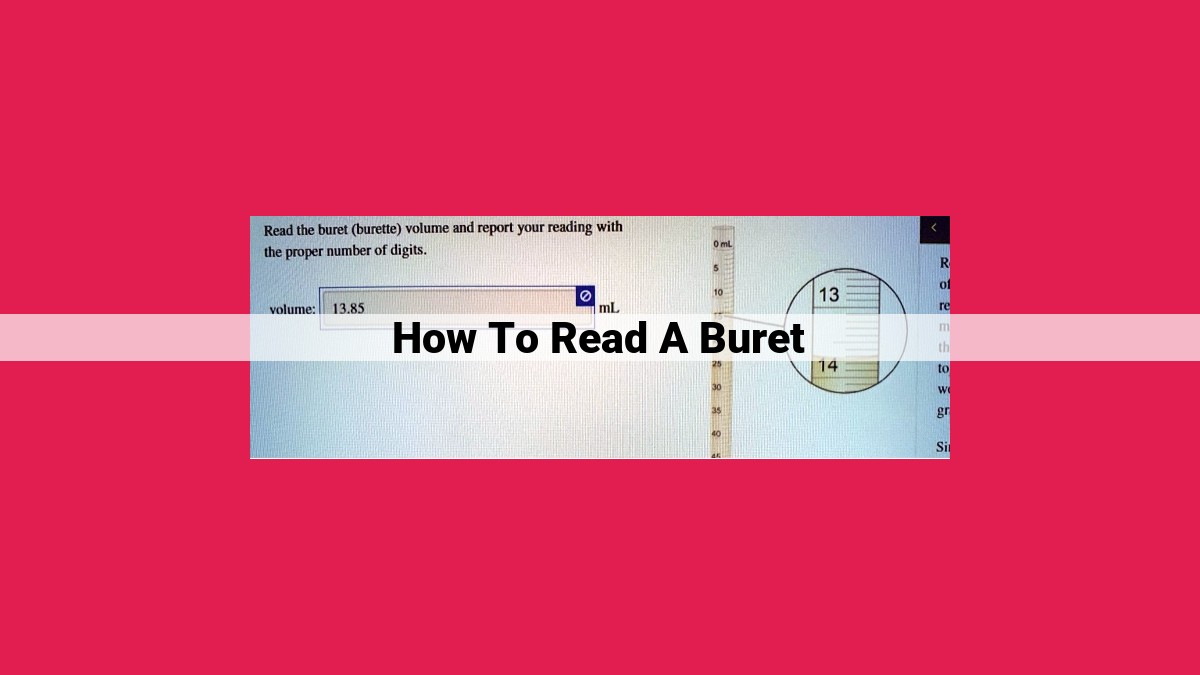Mastering Buret Reading: A Guide To Accurate Liquid Volume Measurement

To read a buret, establish eye level at the bottom of the meniscus, the curved surface of the liquid. Note the position where the bottom of the meniscus aligns with the buret scale to determine the volume. Avoid parallax error by aligning the top of the meniscus with the same level, minimizing its effect on the reading. Accurately reading the meniscus is crucial for precise liquid volume measurements in laboratories.
How to Read a Buret: A Comprehensive Guide to Meniscus and Related Concepts
In the realm of scientific experimentation, precise measurement is paramount. Among the indispensable tools for accurate liquid volume determination is the buret. This blog post aims to guide you through the art of reading a buret, focusing on the crucial concept of the meniscus and related principles. Understanding these concepts will empower you to obtain precise measurements, ensuring the accuracy and reliability of your experimental data.
The Importance of Meniscus
The meniscus, a curved liquid surface found in burets, is a key factor in accurate volume readings. The shape and position of the meniscus depend on the liquid’s properties and the surface tension between the liquid and glass. Recognizing and interpreting the meniscus is essential for precise measurements.
Understanding the Meniscus: The Key to Accurate Buret Reading
In the realm of science, precise measurement is paramount. When it comes to measuring liquid volumes, burets stand as indispensable tools. However, the accuracy of these measurements hinges on our ability to understand and interpret the meniscus – a crucial phenomenon that can make or break our results.
The meniscus refers to the curved surface that forms when a liquid is contained in a narrow tube, such as a buret. This curvature arises due to the interplay of surface tension and gravity. Depending on the nature of the liquid, the meniscus can assume different shapes:
-
Concave Meniscus: Liquids like water exhibit a concave meniscus, curving upwards along the walls of the buret. This is attributed to the cohesive forces within the liquid molecules, which draw them together and minimize their contact with air.
-
Convex Meniscus: In contrast, liquids like mercury exhibit a convex meniscus, curving downwards along the buret walls. This shape results from the stronger cohesive forces between mercury molecules, which repel the walls of the container.
Understanding the Meniscus: A Crucial Concept for Accurate Buret Readings
When measuring liquid volumes with precision, burets play a pivotal role. However, obtaining accurate readings requires a thorough understanding of the meniscus and related concepts.
Eye Level: The Key to Precision
To avoid parallax error, it is essential to position your eye level at the bottom of the meniscus. Parallax occurs when the observer’s line of sight is not perpendicular to the buret’s scale. By placing your eye level at the bottom of the meniscus, you eliminate any parallax error and ensure an accurate reading.
Bottom of the Meniscus: A True Reflection
The bottom of the meniscus marks the true liquid level in the buret. This is due to the cohesive forces between liquid molecules, which cause the liquid to curve upward at its surface. To accurately determine the volume of liquid in the buret, align the bottom of the meniscus with your eye level.
Top of the Meniscus: Minimizing Parallax Error
While the bottom of the meniscus is crucial for accuracy, the top of the meniscus can help minimize parallax error. The top of the meniscus should be slightly below your eye level. By observing both the top and bottom of the meniscus, you can effectively reduce parallax error and ensure a more precise reading.
Parallax: The Enemy of Accurate Measurements
Parallax is a phenomenon that can distort your perception of the meniscus. It occurs when your line of sight is not perpendicular to the buret’s scale. Parallax can lead to inaccurate readings, as the meniscus appears to be at a different level depending on your viewing angle. By aligning your eye level properly and observing both the top and bottom of the meniscus, you can minimize the impact of parallax and improve the accuracy of your readings.
Volume Reading: Unlocking the Secrets of Liquid Measurement
When it comes to measuring liquid volumes, precision is paramount. Burets stand as indispensable tools in this endeavor, but their accuracy hinges on our ability to read the meniscus with unwavering precision.
Aligning the Eye: The Crux of Accuracy
To conquer the art of meniscus reading, we must first master the technique of eye alignment. Position your eye level with the bottom of the meniscus, ensuring that your line of sight is perpendicular to the buret. This eliminates parallax error, a distortion that occurs when your eye is not perfectly aligned.
Bottom and Top of the Meniscus: Guiding Marks for Volume
The bottom of the meniscus serves as a reference point for volume reading. By aligning your eye with its lowest point, you establish a solid foundation for accurate measurements.
The top of the meniscus offers a contrasting guide. Its rounded shape can create an illusion of greater volume, but remember to disregard this and focus solely on the bottom meniscus.
Reading the Liquid’s Tale: A Step-by-Step Guide
-
Identify the Bottom Meniscus: Locate the lowest point of the liquid’s curvature, aligning your eye directly in line with it.
-
Set Your Eye Level: Position your head so that your line of sight is perpendicular to the buret.
-
Observe the Meniscus: Focus on the bottom of the meniscus, noting its position on the buret’s calibration scale.
-
Read the Volume: Read the volume value at the point where the bottom meniscus aligns with the scale.
-
Double-Check: Repeat this process for the top meniscus, noting the value. The difference between the two readings represents the liquid’s true volume.
Mastering these techniques will transform you into a proficient buret reader, empowering you with the precision necessary for accurate liquid volume measurements.